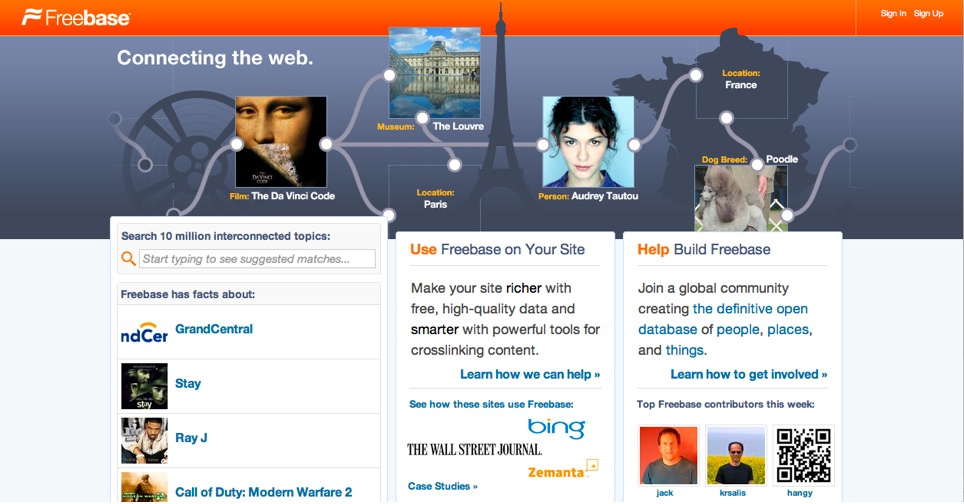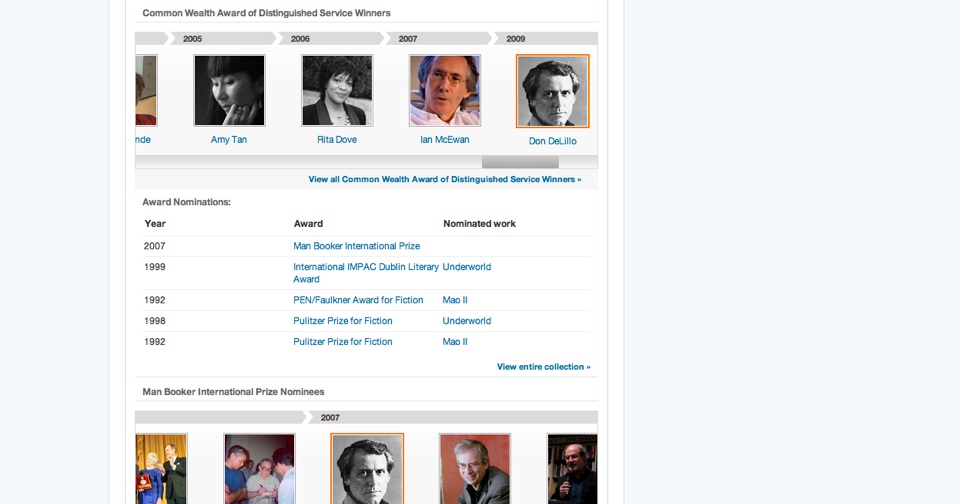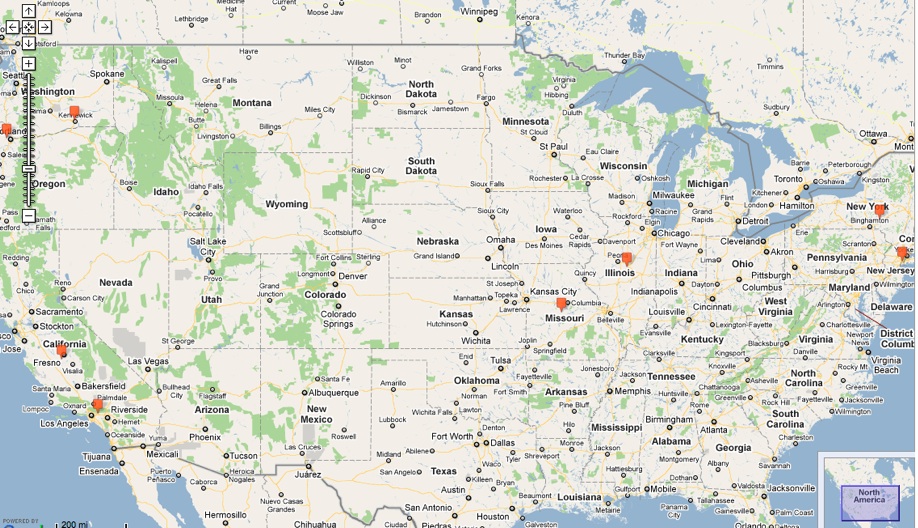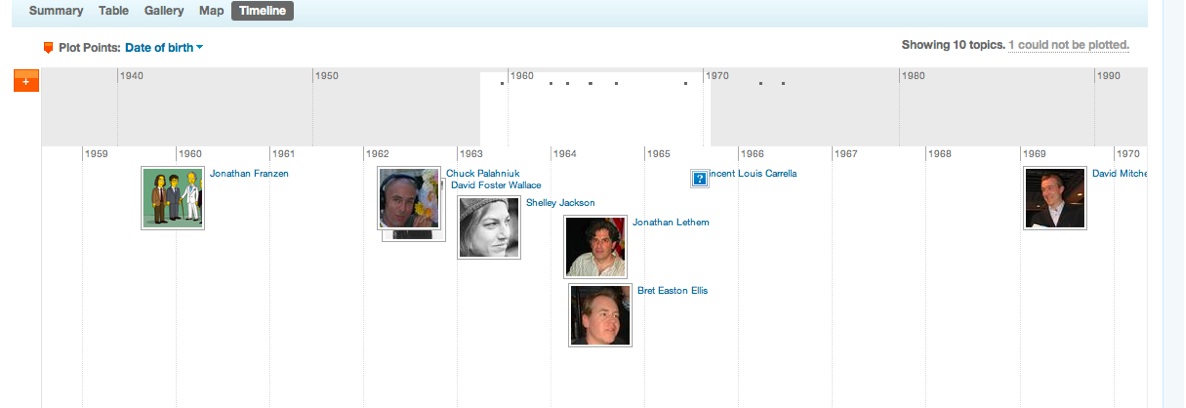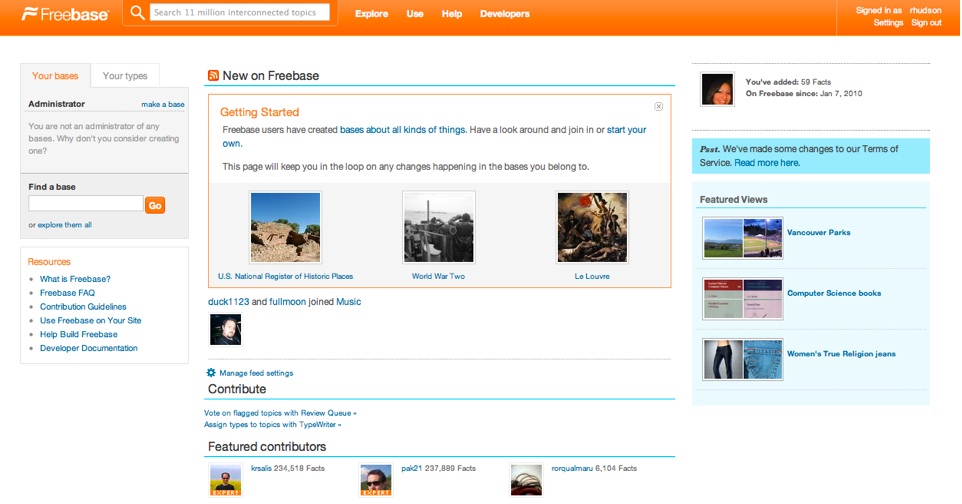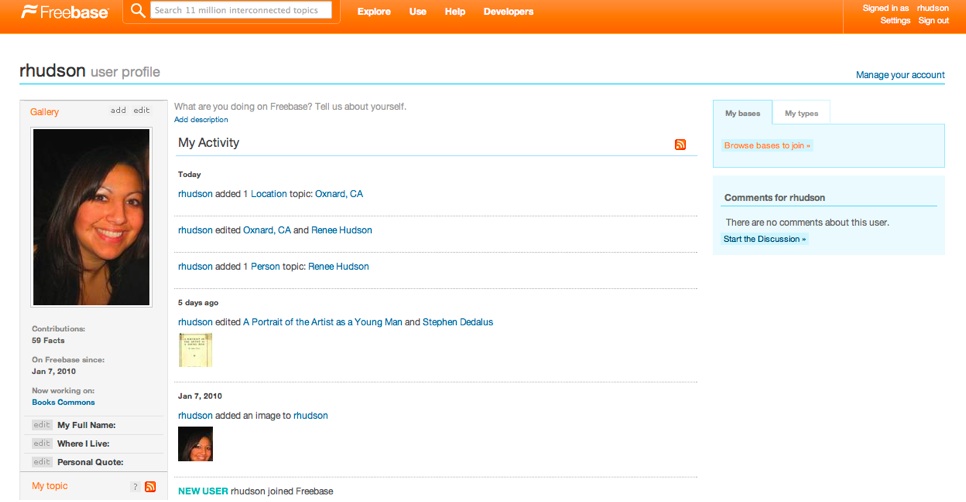(created 1/30/2010; version 1.0)
Related Categories: Social Networking Systems | Tools for Analyzing Social Networks| Online Knowledge Bases | Text Visualization
Summary:
On March 9, 2007, Metaweb Technologies unveiled Freebase.com, an open database that pulls information from public sources like Wikipedia, MusicBrainz, Netflix, and the Securities and Exchange Commission. Like a wiki, Freebase also allows users to add their own content to contribute to the knowledge base of the website. However, unlike search engines that point a user toward a list of websites, Freebase connects users with clusters of information that emphasize relationships among pieces of data.
Description:
Freebase uses a non-hierarchical data structure to emphasize connections between nodes of data. In addition to pulling data from already existent databases like TVRage.com, Freebase also has a strong community of users who add data and edit entries. Users can log in to the website, and create their own profile, though the emphasis is less on social networking and more on contributing and maintaining content on Freebase.
For users looking for information, a search box on the homepage (prefaced by the statement “search 10 million interconnected topics”) generates a list of results from which to choose. For instance, a search for “Don Delillo” lists search results along with
Screen grab: Sample Freebase search.
relevant “types,” which the website explains as “a group of properties that describe a topic.” The types listed for the first “Don Delillo” search results lists the following types: “Person,” “Film Writer,” “Author,” “Influence Node,” “Award Winner,” and “Award Nominee.” Other search results generated include “Underworld,” which includes the sole type “Book Edition.” A user who edits the topic can add types from a list of types in addition to creating a new type.
Clicking on the first search result for “Don Delillo” takes the user to the entry on the White Noise author. The entry includes a picture of Delillo, information on Delillo (from Wikipedia), a visualization of Delillo’ books (which users can scroll through, left to right and vice versa), a box that lists films written, a timeline of awards won, another left-right visualization, this time of Common Wealth Award of Distinguished Service Winners, a timeline of award nominations, another left-right visualization of Man Booker International Prize nominees, an Influence Node that lists who he is influenced by as well as who he has influenced, and general biographical information and quotes.
Interestingly, “Influence Nodes” are conceptualized as a “Genealogy of Influence” that Freebase describes as a significant influence between people (not movements, groups, or schools), nor a “casual influence or general inspiration.”1 Clicking on the phrase “Influence Node” takes the user to a new webpage, which lists people on a table that includes “Name,” “Image,” “Influenced By,” “Peers,” “Influenced,” and the Freebase article. At the top of the table, users can filter by “Name,”
Screen grab: Influence Nodes
“Influenced by,” “Peers,” or “Influenced.” While the table view is the default view of this node, another view is “Summary,” which presents the people in the “Influence Node” as a set of boxes, with snippets from each article and picture of each person in each box. Alternatively, users can use “Gallery” view, which shows the pictures of the people in this node, or “Map” view, where a user cangenerate locations on a map (for example, “Places lived: Location” or “Place of Birth”) and make sense of influences spatially.
Map View: Places Lived: Location for those Influenced by Don Delillo
Lastly, Freebase also offers a “Timeline” view which allows a user to select plot points like “Date of Birth” or “Employment History” to view data temporally. Significantly, Freebase determines the types of information that can be plotted such that one
Screen grab: Timeline View: Date of birth for those Influenced by Don Delillo
cannot track or create locations from a text (such as Bloom’s Dublin in James Joyce’s Ulysses) or add, say, publication dates for an author’s work.
In addition to the information on the entry regarding Don Delillo, a small sidebar on the left allows a user to access pieces of information more quickly – like the Awards section – while sidebars on the right include a button to “Edit This Topic” as well as an Amazon link to purchase books by Don Delillo and another link to purchase DVDs. There is also a Netflix link to rent DVDs.
Screen grab: Site sidebars
Another right-hand sidebar also offers links for Related Topics as well as links for the subject of the entry – here, Don Delillo – elsewhere on the internet, which can include anything from an official website, to Wikipedia to The New York Times or TVRage.com.
Searching for a piece of information other than an author will of course generate different categories and types of information, but the basic principles remain the same – provide basic data and link that data to relevant clusters of information. Following this framework, a search for Ireland takes users to the Ireland entry, which provides information from Wikipedia, along with sections on “Location,” “Governmental Jurisdiction,” “Breeds that Originate in Ireland (like the Irish Wolfhound),” “Fictional Settings (the entry notes that Stephen Dedalus from James Joyce’s A Portrait of the Artist as a Young Man and Ulysses was born in Ireland),” “Filming Locations (films in which Ireland was featured),” “Literature Subjects,” “Olympic Participating Country” information, and “Facts From the Community.”
Contributing users access their own homepage, which includes, on a left-hand sidebar, a section entitled “Your bases,” where a user can access a base (“a collection of topics about something you love”2 ) they’ve created or contribute to. Users can also access
Screen grab: Sample Freebase User Profile
a tab titled “Your types,” which allows users to create their own types. The main focus of the homepage is to provide a newsfeed that informs the user of any changes made to bases of which a user is a part. This section also includes a link where users “Vote on flagged topics with Review Queue.” Once clicked, this link shows the flagged topic (which appears to be choosing the best entry for a topic when more than one already exists) and allows users to review the relevant material, vote for which side wins, whether or not to merge the data, or skip the review process entirely for that particular flagged topic. After making the appropriate selection, another flagged topic appears, using a visualization that replaces the former flagged topic with the new one by moving the page right to left. There is also another link where users can “Assign types to topics with Typewriter.” This feature addresses the problem of making sense of descriptions. As the website notes, there “are thousands of topics that we think might be People, Companies, Buildings and the link. Tell us whether we’re right or wrong! Simply click Yes or No, and your opinion will help build Freebase’s data.”3 A user then clicks on a section on which to vote (“Published Work” and “Film” are two examples of these sections) to help make sense of the data.
The right-hand sidebar of the user homepage shows “Featured Views,” which highlights certain entries, and at the top, a user can see his or her profile picture along with number of facts s/he has added and how long the user has been with Freebase. Clicking on one’s picture redirects to the user’s profile page. The left-hand sidebar of this page shows the user’s photo, number of contributions, duration on Freebase, bases s/he is currently working on, and, if the user has provided this information, full name, location, and a personal quote.
Interestingly, at the bottom of the left-hand sidebar is a section titled “My topic,” where a user can add his or herself to the Freebase database. Doing so links a user’s profile with the editable public entry available on Freebase. As the user linked with the topic, the user can remove the entry, monitor it, and subscribe to it as an RSS feed.
The main section of the user profile includes a section to provide a description of why a user is on Freebase as well as a detailed list of Freebase related activity, sorted by date. Below user activity is a section called “Favorite Topics” where a a Gallery view of topics a user as marked as a favorite is shown. There is also a link, “View Activity Details,” which can be clicked on to see more detailed information about a user’s contributions to the Freebase database, which can also be filtered by date.
The right-hand sidebar provides another set of tabs for a user’s bases and types as well as a section for comments for the user.
Each page within Freebase contains a link at the bottom which allows users to view the Page History as well as Freebases’ Resource Description Framework (RDF), a set of specifications recommended by the World Wide Web Consortium (W3C) for describing information.
Research Context:
Freebase articulates information as clusters of relationships in much the same way RoSE seeks to identify meaningful sets of relationships between people and texts. As such, Freebase provides a useful model for RoSE in terms of how to make sense of data relationally rather than seeing information as existing in separate nodes. Simultaneously, the existence of a strong user community in relation to the database provides one manifestation of how social computing relates to information, though Freebase focuses on the information contained within the database more so than the people who contribute to the database to such an extent that, as seen in the ability to create “My topic” out of one’s profile – the database in effect makes data out of everyone, as exemplified by this feature.
Technical Analysis:
The majority of Freebase is written in Python, though some sections are served by Acre, a javascript hosting environment for Freebase. As of October 29, 2008, users can access Freebase’s RDF. In addition to providing RDF to users who wish to make Semantic Web applications, Freebase also allows users to download data dumps, create Freebase queries using MQL (via the Query editor), and generally use the Freebase API and Acre to make a variety of applications by accessing Freebase data. However, it must be noted that the database itself is not open source, but data on the site is freely available. The site currently supports Firefox, Safari, and IE.
Evaluation of Opportunities/Limitations for the Transliteracies Topic:
While RoSE can benefit from Freebase’s approach to presenting data as clusters of information with user friendly visualizations to illustrate connections, the social networking aspect of Freebase offers an interesting departure from RoSE as currently conceived. In short, because RoSE seeks to create fine grained relationships among people and documents in a socially networked environment, RoSE needs to decide on the relationship between users and data. For Freebase, because the emphasis for users is on adding to the already vast body of knowledge on the website, users exist in the service of data rather than vice versa. As such, Freebase privileges information above personhood to such an extent that, as evidenced by the example of “My topic,” persons become converted into data.
The persistence of statistics on sites like Freebase recalls what Mark Seltzer has elsewhere referred to as “statistical persons.” While Seltzer uses the phrase in relation to the realist novel, which for him is defined by the desire to “account for” persons (Seltzer 93), within the context of sites like Freebase, the desire to account for accounting emerges as the dominant modus operandi. By this I mean that one’s social identity becomes statistically constituted such that one constantly surveils one’s own statistical constitution on the micro level, which in turn is repeated on the macro level as part of a larger system of accounting performed by the creators of Freebase itself.
Playing off what Kathleen Woodward has referred to as “statistical panic,” an emotional state in which a fear of one’s own mortality arises because of the proliferation of probabilities that signal one’s demise, sites like Freebase give rise to a sort of “statistical anxiety” caused by the recognition that one is only socially constituted insofar as one is statistically constituted. The choice to be “reduced” to a statistic recalls what Jaron Lanier has recently referred to as the creation of “standardized presences” on social networking sites, in which identity is constructed based on a limited number of options provided by whichever social networking site used.
However, the creation of a standardized presence on Freebase is expanded by the ability to add new pieces of information for categorization. While one could argue that categorization still forces the user to think of information and her/himself in terms of categories, this also contributes to the existence of more fluid ontologies within the site. As Tim O’Reilly notes, by allowing users to create their own types rather than focusing on the W3C “approach to the semantic web, which starts with controlled ontologies, Metaweb adopts a folksonomy approach, in which people can add new categories (much like tags), in a messy sprawl of potentially overlapping assertions.”4 Freebase’s approach thus focuses on fluid ontologies created collaboratively, which, “if Metaweb gets this right, this bottom up approach will build new connections between data, new categories and ways of thinking . . . [which then builds] new synapses for the global brain.”5 By likening Freebase to a “global brain,” O’Reilly foregrounds the capacity for the database to not only make connections between data, but also to “learn” connections between new relationships and pieces of information such that rather than outgrowing categories, the database can evolve. The statistical unease generated by the site coupled with the metaphor of Freebase as an evolving brain significantly reduces the human to a number and anthropomorphizes the database (“information wants to be free”6), which no doubt sparked the allusion to Skynet in one of the early reviews of the site: “This is cool, unless it achieves consciousness and kills us all.”7
While likening Freebase to Skynet sensationalizes the capabilities of Freebase, the analogy is relevant to RoSE in that the allusion points to a need to unpack the ontological implications of RoSE features. Are people treated equal (or even subject) to data? What does it mean to weigh texts and people equally? Such equality is not inherently a bad thing, but the ways in which this equality is framed determines the extent to which the human figures in RoSE.
Notes:
1. “Influence,” Freebase.com, 15 January 2009. http://www.freebase.com/view/influence
2. “Make your own base,” Freebase.com, 15 January 2009 . http://www.freebase.com/base/createbegin
3. “Typewriter,” Freebase.com, 15 January 2009 . http://typewriter.freebaseapps.com/
4. “Freebase Will Prove Addictive,” O’Reilly Radar, 8 March 2007, 15 January 2009. http://www.freebase.com/view/en/are_you_connected_to_other_open_data_projects
7. “This is cool, unless it achieves consciousness and kills us all,” TechCrunch, 9 March 2007, 15 January 2009 http://www.techcrunch.com/2007/03/09/this-is-cool-unless-it-achieves-consciousness-and-kills-us-all/.
Resources for Further Study:
- Arrington, Michael. “This is cool unless it achieves consciousness and kills us all,” TechCrunch, 9 March 2007: n. pag. Web. 15 January 2009.
- Freebase.com. 2010. Metaweb Technologies. Web. 15 January 2009.
- Lanier, Jaron. You Are Not a Gadget. New York: Alfred A. Knopf, 2010. Print.
- O’Reilly, Tim. “Freebase Will Prove Addictive,” O’Reilly Radar, 8 March 2007: n. pag. Web. 15 January 2009.
- Seltzer, Mark. Bodies and Machines. New York: Routledge, 1992. Print.
- Woodward, Kathleen. “Statistical Panic.” Differences: A Journal of Feminist Cultural Studies
11.2 (1999): 177-203. Print.

